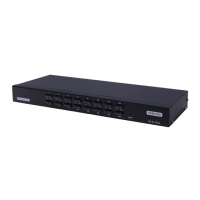9
OSD Navigation:
• To dismiss OSD, press [Esc].
• To move up and down through the list one line at a time, use the Up and
Down Arrow Keys. If there are more list entries than what can appear on
the main screen, the screen will scroll.
• To activate a port, move the highlight bar to it then press [Enter].
• After selecting a port, the OSD menu automatically disappear, and a blue
tip window appears to indicate the port currently selected.
[F1] [F2] [F3] [F4] [F5] [F6] at the bottom of the screen is the function setting of
the OSD menu. And the corresponding function operation and setting are
performed through the corresponding buttons on the keyboard.
OSD Main Screen Headings:
Heading Explanation
PN
This column lists the port numbers for all the CPU ports on the
installation. The simplest method to access a particular
computer is to move the highlight bar to it, then press [Enter].
QV
If a port has been selected for Quick View scanning, an
arrowhead symbol displays in this column to indicate so.
PC
The computers that are powered on and are on line have an
arrowhead symbol in this column to indicate so.
NAME If a port has been given a name, its name appears in this column.
OSD Functions:
OSD functions are used to configure and control the OSD. For example, you can:
rapidly switch to any port; scan selected ports only; limit the list you wish to view;
designate a port as a Quick View Port; create or edit a port name; or make OSD
setting adjustments.
F1 GOTO:
Press the [F1] key to start the GOTO function. The GOTO function can allow you
to switch directly to the connection port by typing the port name or its port
number.

